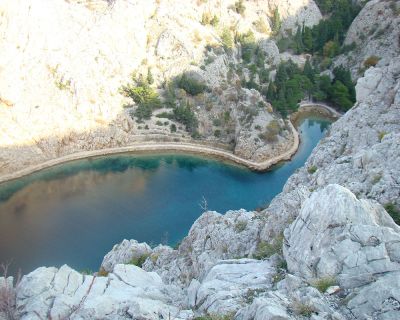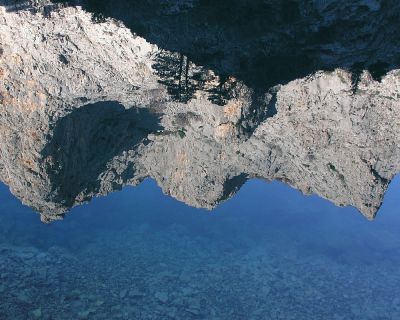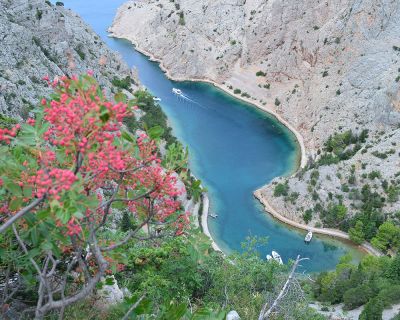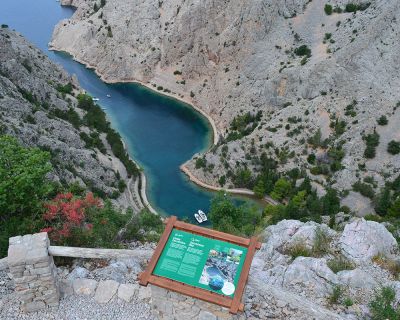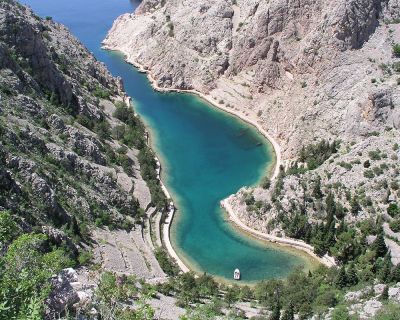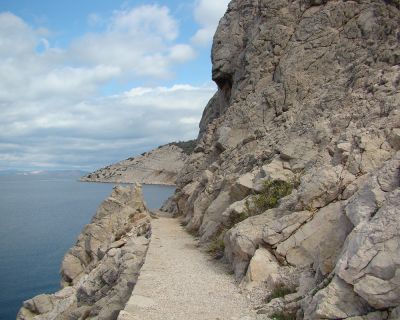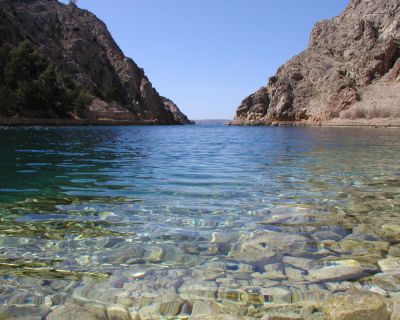Zavratnica is a stunning inlet near the village of the same name, not far from Jablanac, formed by the flooding of a torrential valley. It stretches approximately 900 meters in length and varies between 50 and 150 meters in width. With steep shores rising up to 100 meters, Zavratnica closely resembles a small fjord. To counter the effects of torrents, terraced cascades were built using the traditional dry-stone wall technique. These terraces are now planted with cypress, Aleppo and black pine, fig, holm oak, and other tree species, enhancing the landscape's natural beauty.
The flora of Zavratnica includes 116 plant species, of which 24 are legally protected. Some notable species include: Iris illyrica (Illyrian iris), Salvia officinalis (common sage), Ruta graveolens (rue), Olea europaea (olive tree), Agave americana (American agave), Paliurus spina-christi (Christ’s thorn) and many others.
Zavratnica Cove is part of NATURA 2000, an ecological network of areas important for the conservation of endangered species and habitat types within the European Union. In 1964, an area of 400 hectares was designated as a significant landscape, and since 1981, Zavratnica has been included within Velebit Nature Park.
At the beginning of the 20th century, a scenic upper trail with a viewpoint and a seaside promenade were constructed. Around this time, Zavratnica became a retreat for the elite from Vienna and Prague, offering secluded summer refuge.
One of the landscape’s features is a tunnel built in 1930. The area’s enchanting appeal also drew the famous writer Vjenceslav Novak, who found inspiration for his works here.
The steep slopes of Zavratnica Bay sealed the fate of two young pilots of British aircraft. At the end of May 1944, with the opening of a base on the island of Vis, the first attacks on ships in the northern Adriatic began. In Zavratnica, the most significant attacks were carried out by British Hurricanes from a base located in Italy (No. 6 Squadron). Each attack started from land toward the sea, with the aircraft diving through the canyon all the way to the sea. On three occasions, planes were shot down. The first fatal crash occurred on July 7, 1944, when the aircraft of pilot Roland McCafferty (designation KX804), after being hit, struck the southern slope of the bay’s hill. The second loss occurred on August 27, 1944, when during an early morning attack, James Brown’s aircraft (designation KZ243) was hit and, while exiting the bay, struck the rocks and exploded. Both pilots are still listed as missing in action. The third and final aircraft crash happened on September 19, 1944, but with no casualties. Pilot Ulrich bailed out of his plane near the Zadar archipelago and was rescued by a partisan vessel.
At the very beginning of the bay, remains of a warship known as the "Siebel ferry" can be seen—namely, a twin-hulled landing craft produced by the German Navy specifically for Operation "Sea Lion." By connecting two pontoons with a steel platform, Colonel W. Siebel created a vessel with a simple design, sturdy construction, and good durability. This unique craft proved highly useful as a transport anti-landing ship, gunboat, and minelayer.
During World War II, thanks to its steep and high slopes, Zavratnica served as an excellent shelter for German warships. Considering that in 1944 there was a major concentration of German vessels in Jablanac and Zavratnica, attacks were frequent. On August 25, 1944, an attack by five British aircraft took place, targeting two patrol boats (designations LF122 and LF126). After the second strike, one of the boats sustained heavy damage and sank just off the shore of the bay, where it remains to this day. Only the steel framework remains, revealing its size, while its secrets and stories remain forever submerged.
Gallery
How to get there
You can reach Zavratnica by footpath along the sea from the direction of Jablanca, in approximately 20 minutes' walk. If you are more of a mountaineer and adventurer, you can go down to the bay by hiking trail from the village of Zavratnica.



